Breeding of Leopard Cat (Felis bengalensis) in Bhagwan Birsa Biological Park, Ormanjhi, Ranchi
Dr. Ajay Kumar*
Bhagwan Birsa Biological Park is situated in lush green natural Sal (Shorea robusta) forest of Ormanjhi Block. It is situated on the Ranchi-Ramgarh section of the National Highway 33. The total area of the Biological Park is 104 ha. Out of 104 hectare area, the zoological section is spread in 83 hectare. It is categorized as medium zoo by Centre Zoo Authority of India, which exhibits more than 1100 wild animals belonging to 72 Species. Out of these 72 species around 28 species (04 Avian, 15 Mammalian and 09 Reptilian) are of schedule I & II category as per Wildlife Protection Act 1972.
Spotted Deer (Axis axis), Black Buck (Antelope cervicapra), Albino Black Buck (Antelope cervicapra), Himalayan Black Bear (Selenarctos thibetanus), Sambhar (Cervus unicolor), Jackal (Canis aureus), Indian Gaur (Bos gaurus), Hyaena (Hyaena hyaena), and Leopard Cat (Felis bengalensis) are the species breeding regularly in this zoo.
Among these species, Leopard Cat, Indian Gaur, Black Buck, Albino Black Buck, and Himalayan Bear are of schedule I category as per WPA 1972.
Leopard Cat (Felis bengalensis) :
The leopard cat (Felis bengalensis) is a small wild cat of South East Asia. It is about the size of domestic cat but more slender with larger legs and well defined webs between the toes. Its small head is marked with two prominent dark stripes and a short and narrow white muzzle. The two dark stripes running from the eyes to the ears and smaller white streaks running eyes to the nose.
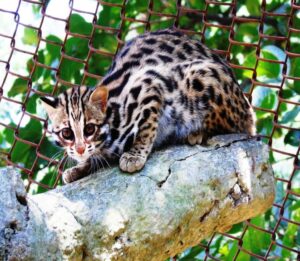
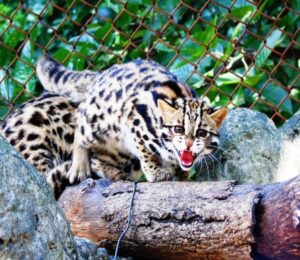
Leopard cats are the most widely distributed Asian small Cats. Their distribution range extends from Amur region in the Russian Far East over the Korean peninsula, China, Indochina, the Indian to the west in northern Pakistan and to the South in Philippines and the Sunda Islands of Indonesia (Sunquist, M.; Sunquist F. 2002)

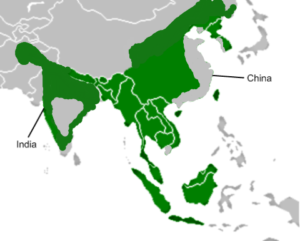
IUCN – Asian Leopard Cat Distribution Range
Diet of Leopard Cat :
The diet of Leopard Cat in nature is rodents (rats and mice), smaller mammals, birds and their eggs. Diet in the zoo is dressed chicken meat (500g per adult per day) and 5 ml multivitamin syrup per adult per day.
Conservation Status :
The population trend is decreasing due to habitat loss and Poaching for global illegal wildlife trade.
As per
- Wildlife Protection Act 1972 – Schedule I
- IUCN (International Union for Conservation of Nature) Red list of threatened species – Least concerned since 2002.
- CITES (Convention on International Trade in Endangered species of Flora & Fauna) – Appendix – II.
- US Federal list – Endangered.
Species Characteristics :
- Sexual Maturity is reached around 12- 15 months
- Gestation period 65 – 75 days.
- Litter size – 01 to 04
- Weight at birth – 80-90 grams.
- Eyes of newly born kitten open in 5-15 days.
- Average life span is 04 (Four) years in wild but in captivity the leopard cats have been known to live 12-15 years.
Breeding History in Bhagwan Birsa Biological Park :
One pair (1:1) of leopard cat (Felis bengalensis) was brought from Assam state Zoo, Guwahati on 22.03.2012 and they are breeding regularly since June 2012 (Brief History is as below)
- First mating of the pair was noticed on 24th and 25th March 2012
- First birth on 3rd June 2012 (Litter size 01)
- 2nd birth on 4th April 2013 (Litter size 01)
- 3rd birth on 7th April 2014 (Litter size 02)
- 4th birth on 27th March 2015 (Litter size 02)
After parturition the mother Leopard cat nurtured her kids with good mothering ability and there is no any case of rejection of offspring or cannibalism was noticed in Bhagwan Birsa Biological Park.
Good ambience & climatic condition, stress free enclosure and balanced ration maintains the physiological & hormonal balance in wild inmates of Bhagwan Birsa Biological Park, Ranchi, which results in successful breeding. Now the present population of leopard cat grows to 8 (2:2:4) within three years in Bhagwan Birsa Biological Park, Ranchi and seems to be a good resource for animal exchange programme within the zoos of India and abroad.
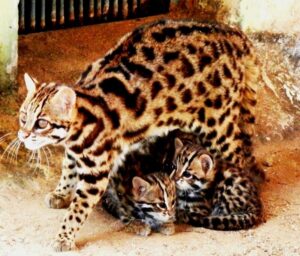
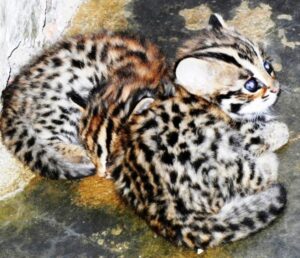
*Dr. Ajay Kumar, M.V.Sc. (Animal Breeding and Genetics), Zoo Vet., BBB Park, Ranchi
Reference :
Sunquist, M. ; Sunquist, F. (2002) : Wild Cats of the World, Chicago, University of Chicago press PP 225- 232.


